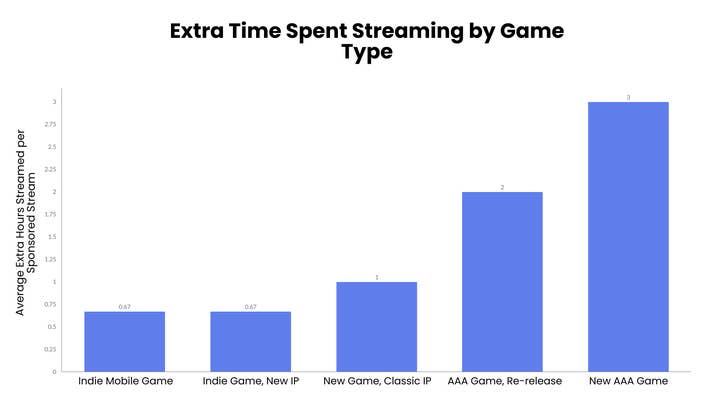The performance marketing approach to working with influencers
Gamesight's Nikki Demmel on how to make the most out of partnerships with content creators
Content creators are one of the most effective avenues for marketing products in the 21st century, yet many companies are still hesitant to depart from the traditional marketing tactics they're used to.
Newcomers to influencer marketing may balk at an influencer's going rate for a sponsorship and question if the return on investment truly works in their favor. Applying a performance marketing mindset to campaign management helps quantify success in influencer campaigns, identify how influencers fit into long-term marketing strategies, and encourage effective campaign iteration.
Based on our experience running influencer campaigns at Gamesight, here are six tips to make the most out of sponsorships with content creators.
- 1. Collect in-depth data on how sponsored content performs
- 2. Find content creators who fit well with your IP and branding
- 3. Take note of who influences the influencers
- 4. Periodically offer organic creators sponsorship opportunities
- 5. For lesser-known games, use ad integrations
- 6. Iterate to refine your long-term strategy
1. Collect in-depth data on how sponsored content performs
Every sound performance marketing campaign starts with a plan to ensure data informs every step of the process, from influencer discovery to deliverable requirements to content scheduling and beyond.
To narrow down what kinds of data your campaign team should keep track of, you first need to identify your campaign goals. With concrete KPIs in place, you can map out what kinds of data you'll need to collect at each stage of your campaign.
Aside from standard performance metrics like viewership numbers and click-through rates, keeping track of even minute details like the days content goes live or extraneous circumstances surrounding the timing of a deliverable can help in contextualizing the raw performance data of paid influencers.
From a content creator's perspective, any data you can share with the creator that shows your game would resonate with their audience is welcome
Anticipating what data will be collected ahead of time is the best way to ensure your campaigns can be iterated on. In time, you'll be able to narrow down the most effective parts of your strategy that drive campaign performance.
From a content creator's perspective, any data you can share with the creator that shows your game would resonate with their audience is welcome. For every one of our influencer campaigns, we generate an estimate of each creators' ACV change if they were to switch from streaming their main game to a sponsored one. This estimate takes into account how often a streamer plays different games and how their viewership changes with the genre of game streamed.
Creators are in the business of growing their community; when they're approached with sponsorships that put their viewership numbers at risk, expect them to charge an increased rate for any kind of activation. If your game is received especially well by their followers, they might put it into their regular content rotation. This best-case scenario means you've turned a paid player into an organic one, greatly increasing your initial return on investment.
2. Find content creators who fit well with your IP and branding
Creators appreciate brands that take the time to assess if their channels are genuinely good fits for the given product. The time you spend identifying creators who are likely to enjoy your game turns into extra marketing value when they stream longer than their contracted playtime, make additional social media posts, or otherwise go the extra mile in their content to gush about your game.
Creators appreciate brands that take the time to assess if their channels are genuinely good fits for the given product
Across five of our most recent paid influencer campaigns, we've seen creators spend an extra 1.47 hours on average streaming sponsored titles, simply because they liked the game. More qualitatively, sponsoring people who will likely enjoy your title means you're getting authentic and enthusiastic pitches for the game straight from people that your targeted audiences trust.
In our experience running influencer campaigns, new AAA games tend to see the most enthusiasm from creators, while indie games, both in the mobile space and console/PC games from new IPs, tend to see the least. This is reflected not only in sponsorship offer response rates, but also in extra time streamed once a creator's contractual obligations are filled.
The graph below breaks out additional hours creators spend playing a sponsored game by five classifications: indie mobile games, indie games from a new IP, new non-indie games from a recognizable IP, re-releases of AAA games (either enhanced versions of an existing title, or ports to a new platform), and new AAA games.

3. Take note of who influences the influencers
Gaining a deep understanding of the social circles influencers belong to can go a long way in determining where it's best to put your marketing budget. Paying one high-profile streamer to play a game when you know their friends are going to hear about it sometimes encourages creators of similar popularity to stream the game organically. In our experience running influencer campaigns, this is a significant source of additional value.
Gaining a deep understanding of the social circles influencers belong to can go a long way in determining where it's best to put your marketing budget
We typically see streamers influence organic streams from channels that are smaller than their own. This has interesting implications for budget allocation -- you'll need to decide for yourself based on your campaign goals whether investing in smaller streamers with less influence on the platform is better than putting your budget towards a large streamer and hoping other influential creators see their stream.
We refer to organic streams directly attributable to paid influencers as "second-order streams." The graph below shows the biggest second-order stream attributed to each creator from five of our most recent campaigns. From this limited set of data, we can see that smaller streamers with about 400 viewers or less are more likely to be influenced by paid streams than creators with larger audiences.
Furthermore, there is not a strong positive relationship between the popularity of a paid streamer and the popularity of those they influence to stream any given sponsored game. It may be more effective to assess potential paid streamers individually to determine their spheres of influence if second-order streams are a priority for your campaign.

4. Periodically offer organic creators sponsorship opportunities
Though it may seem counter-intuitive, the real value derived from sponsoring existing players is the goodwill and positive working relationships you develop with long-term, influential fans.
Creators experienced with sponsorships are aware that they are unlikely to receive paid opportunities for games they consistently play, though in some ways this may feel like a punishment for being a fan of a game.
Paying them to stream your game if they already play shows your appreciation for their work, and their viewers will take note of the act of goodwill as well. A brand's image cannot be changed overnight, but small, considerate acts like this every once in a while can go a long way in proving to your consumer base that you care about them.

5. For lesser-known games, use ad integrations
A large part of influencer content's effectiveness comes from creators' genuine joy playing the game and from viewer interactions. If your game isn't exciting to show on stream and doesn't encourage viewer participation, consider redirecting your marketing budget towards building name recognition and getting as many eyes as possible on the best parts of your game.
Ad integrations cost less than a full, dedicated YouTube video or Twitch stream and can make for memorable content regardless of their length if influencers' creativity is allowed to shine through.
6. Iterate to refine your long-term strategy
Once all of your data from the planning stage has been collected, you can take a fine-toothed comb to everyone's performance measurements to plan for future campaigns.
An iterative approach can help determine all sorts of campaign tweaks, from platform budget splits, to optimal timing for peak viewership, to creator size ranges and beyond. With each campaign, your goal should be to learn something new about what marketing strategies work for your game, and inch closer to achieving a consistent return on investment.
In conclusion, with each campaign iteration, you should review the kinds of data you aim to collect in the planning stage to see if you're missing any information that could help you make a more informed opinion on future changes.
Seeing campaigns from a content creator's point of view can go a long way in determining who is the best fit for any given game. As long as you take an approach to influencer campaigns that is informed by your past experiences, you should be able to progressively maximize the value you get out of working with content creators.
Similar to more traditional marketing campaigns, going into an activation with clear goals and ways to measure them will ensure that you have a path forward in improving your return on ad spend.
Nikki Demmel is based in Seattle, WA and serves as an influencer campaign manager at analytical marketing partner Gamesight. Through her work, Nikki partners with game developers and publishers to find the best influencers for their marketing campaigns while prioritizing creators and preserving the trust they've built with their communities.
